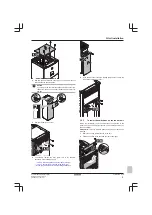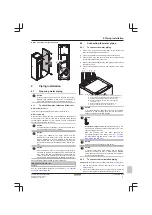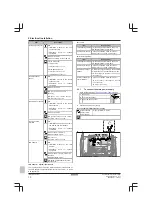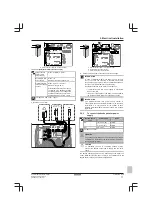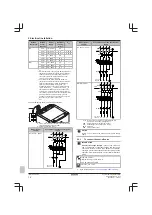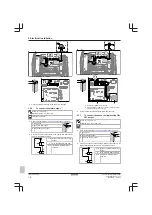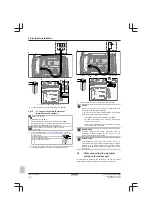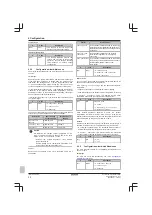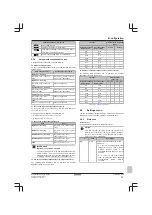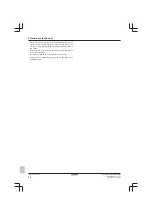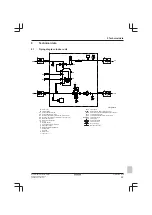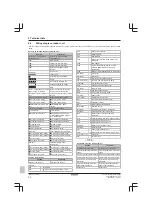
6 Configuration
Installation manual
19
ETVH/9W(G)
Daikin Altherma 3 H HT F
4P586454-1 – 2019.07
#
Code
Description
[4.4]
[7‑02]
▪ 0:
Single zone
Only one leaving water temperature
zone:
a
a
Main LWT zone
[4.4]
[7‑02]
▪ 1:
Dual zone
Two leaving water temperature zones.
The main leaving water temperature
zone consists of the higher load heat
emitters and a mixing station to
achieve the desired leaving water
temperature. In heating:
b
c
a
a
Additional LWT zone: Highest
temperature
b
Main LWT zone: Lowest temperature
c
Mixing station
CAUTION
If there are 2 zones, it is important that the zone with the
lowest water temperature is configured as the main zone,
and the zone with the highest water temperature is
configured as the additional zone. Not configuring the
system in this way could cause damage to the heat
emitters.
CAUTION
If there are 2 zones and the emitter types are wrongly
configured, water of high temperature can be sent towards
a low temperature emitter (underfloor heating). To avoid
this:
▪ Install an aquastat/thermostatic valve to avoid too high
temperatures towards a low temperature emitter.
▪ Make sure you set the emitter types for the main zone
[2.7] and for the additional zone [3.7] correctly in
accordance with the connected emitter.
NOTICE
An overpressure bypass valve can be integrated in the
system. Keep in mind that this valve might not be shown
on the illustrations.
Glycol Filled system
This setting gives the installer the possibility to indicate whether the
system is filled with glycol or water. This is important in case glycol is
used to protect the water circuit against freezing. If NOT set
correctly, the liquid in the piping can freeze.
#
Code
Description
N/A
[E-0D]
Glycol Filled system
: Is the system
filled with glycol?
▪ 0:
No
▪ 1:
Yes
6.2.4
Configuration wizard: Backup heater
The backup heater is adapted to be connected to most common
European electricity grids. If the backup heater is available, the
voltage, configuration and capacity must be set on the user
interface.
The capacities for the different steps of the backup heater must be
set for the energy metering and/or power consumption control
feature to work properly. When measuring the resistance value of
each heater, you can set the exact heater capacity and this will lead
to more accurate energy data.
Voltage
▪ For a
6V
model, this can be set to:
▪
230V, 1ph
▪
230V, 3ph
▪ For a
9W
model, this is fixed to
400V, 3ph
.
#
Code
Description
[9.3.2]
[5‑0D]
▪ 0:
230V, 1ph
▪ 1:
230V, 3ph
▪ 2:
400V, 3ph
Configuration
The backup heater can be configured in different ways. It can be
chosen to have a 1-step only backup heater or a backup heater with
2 steps. If 2 steps, the capacity of the second step depends on this
setting. It can also be chosen to have a higher capacity of the
second step in emergency.
#
Code
Description
[9.3.3]
[4‑0A]
▪ 0: Relay 1
▪ 1: Relay 1 / Relay 1+2
▪ 2: Relay 1 / Relay 2
▪ 3: Relay 1 / Relay 2
Emergency
Relay
1+2
INFORMATION
Settings [9.3.3] and [9.3.5] are linked. Changing one
setting influences the other. If you change one, check if the
other is still as expected.
INFORMATION
During normal operation, the capacity of the second step of
the backup heater at nominal voltage is equal to
[6‑03]+[6‑04].
INFORMATION
If [4‑0A]=3 and emergency mode is active, the power
usage of the backup heater is maximal and equal to
2×[6‑03]+[6‑04].
INFORMATION
Only for systems with integrated domestic hot water tank: If
the storage temperature set point is higher than 50°C,
Daikin recommends NOT to disable the backup heater
second step because it will have a big impact on the
required time for the unit to heat up the domestic hot water
tank.
Summary of Contents for Altherma 3 H HT F Series
Page 33: ......
Page 34: ......
Page 35: ......
Page 36: ...4P586454 1 2019 07 Copyright 2019 Daikin 4P586454 1 0000000U...

